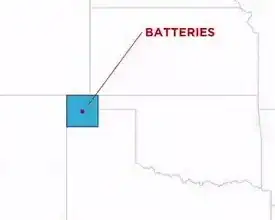Summary: yes, the area shown is reasonable, as a visualisation of the surface area of panels required to generate electricity equal to total US electricity consumption, on a multi-year average: that area of panels would generate 500 GW, which is above the current US annual average electricity consumption of 425 GW
Calculations below are taken from this blogpost at the Energy Institute, University College London.
As Thales Pereira has pointed out in the comments on the question, the claim could be taken to mean that that area of PV would displace fossil fuel, and supplement the existing zero-carbon options on the US grid (hydro, nuclear, wind). That would make it an slightly weaker claim. I've assumed that it's the strong version of the claim: that that area would be the same amount of power as total US demand, even before considering existing hydro, nuclear and wind generation. If the stronger claim is valid, then the weaker claim automatically follows.
- US electricity consumption is about 425 GW on average
- The area shown is 10,000 km2, in NW Texas
Eyeballing this google map and comparing with the graphic in the question: using the scale in the bottom-right corner, the square is about 100km along the side
- Table 2 of Green et al's Solar cell efficiency tables (Version 45) gives the best module as being 24% efficient, giving a PV capacity per unit area of 0.24 GW/km2
- PVWatts gives a capacity factor for Amarillo, Texas, of 21%
10,000 km2 x 0.24 GW/km2 x 21% = 500 GW
Which is more than current US electricity consumption of 425 GW.
So yes, the area shown is reasonable, as a visualisation of the surface area of panels required to generate electricity equal to total US electricity consumption, on a multi-year average.
